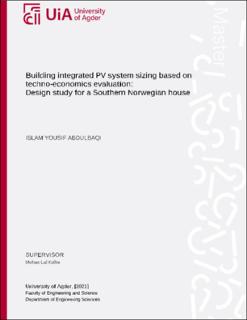| dc.contributor.author | Abdulabqi, Islam Yousif | |
| dc.date.accessioned | 2021-10-06T10:15:21Z | |
| dc.date.available | 2021-10-06T10:15:21Z | |
| dc.date.issued | 2021 | |
| dc.identifier.citation | Abdulabqi, I.Y. (2021) Building integrated PV system sizing based on techno-economics evaluation: Design study for a Southern Norwegian house (Master's thesis). University of Agder, Grimstad. | en_US |
| dc.identifier.uri | https://hdl.handle.net/11250/2788081 | |
| dc.description | Master's thesis in Renewable energy (ENE500) | en_US |
| dc.description.abstract | Renewable energy sources are promising to take a significant share in the energy sector as a viable option for integrating with conventional fossil fuel power plants. This thesis contributes to the ongoing studies about building integrated photovoltaic (BIPV) system energy storage. The system comprises the photovoltaic array to capture solar energy, a power converter to change over AC and DC, a grid connection, and a lead-acid battery to store energy. The modeling is also completed by assessing the required load, specifications and choosing the components associated with the system. The geographic area, solar irradiance, and load consumption upon which the whole work depends are considered. It draws attention to the optimal design and sizing considering several techno-economic factors, including net present cost, cost of energy, and PV power output. The techno-economic analysis of the proposed system is performed by using the software Hybrid Optimization Model for Electric Renewable (HOMER). The simulation result found that the grid-only was the optimal system configuration with LCOE equal to 0.168 kr/kWh and the grid-connected PV system with a storage battery and without having no significant difference in LCOE value. The analysis results for techno-economic performance indicate that the PV energy production and grid supply relationship is powerful and helpful for the system. The analysis among the economic performance and technical indicators may be beneficial for BIPV also. A 10 kW PV array and A battery energy storage (Lead-acid) of 24.8 kWh is considered in this thesis. The BIPV systems energy performance with lead-acid battery storage is analyzed for the grid. The project lifetime is 25 years. During the project’s lifetime, the battery at least will replace3 times. This thesis learning outcome is to have a great understanding of the BIPV system with a storage battery and techno-economical performance. | en_US |
| dc.language.iso | eng | en_US |
| dc.publisher | University of Agder | en_US |
| dc.rights | Attribution-NonCommercial-NoDerivatives 4.0 Internasjonal | * |
| dc.rights.uri | http://creativecommons.org/licenses/by-nc-nd/4.0/deed.no | * |
| dc.subject | ENE500 | en_US |
| dc.title | Building integrated PV system sizing based on techno-economics evaluation: Design study for a Southern Norwegian house | en_US |
| dc.type | Master thesis | en_US |
| dc.rights.holder | © 2021 Islam Yousif Abdulabqi | en_US |
| dc.subject.nsi | VDP::Teknologi: 500::Elektrotekniske fag: 540::Elkraft: 542 | en_US |
| dc.source.pagenumber | 110 | en_US |

